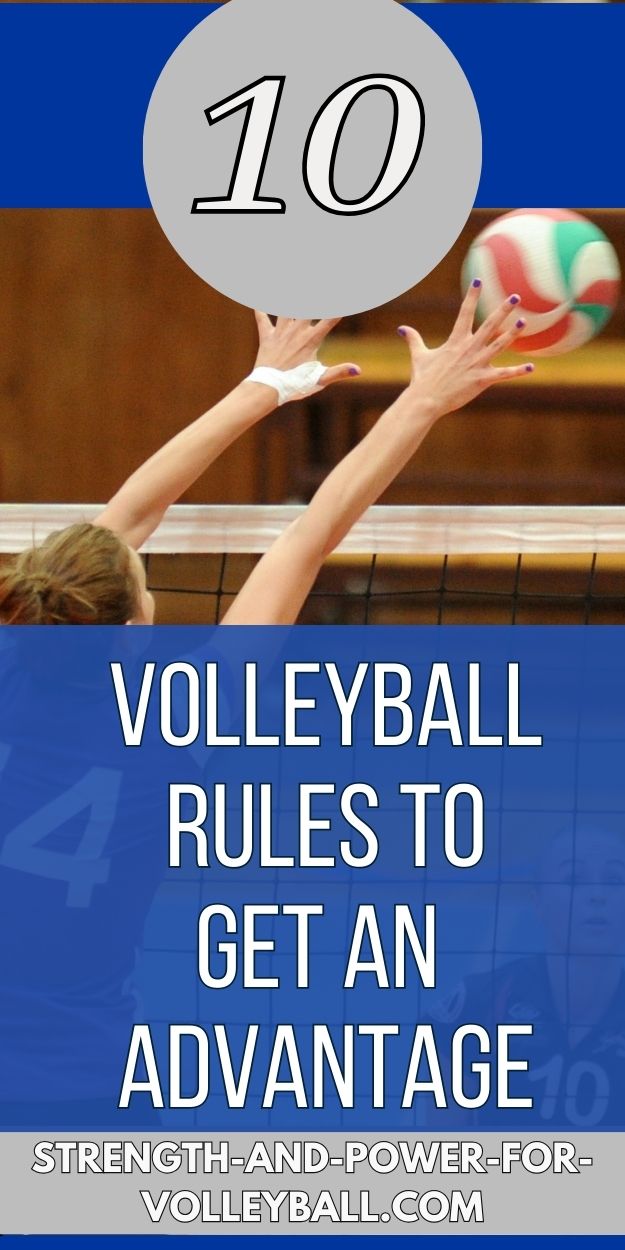10 Rules of Volleyball
Rules Knowledge for an Advantage
Here are 10 rules of volleyball you can use to get an advantage over your opponent. By knowing these rules you will be prepared to win more arguments and help your players make smarter decisions on the court.
Back Row Player Rules - 10 Rules of Volleyball
1) Know When the Setter is Backrow. When the setter is backrow, the setter can't attack or block when near the net. If the backrow setter is inside the attack line, you don't need to worry about the setter attack. The backrow setter can only attack (when the ball is completely above the height of the net) when the setter is beyond the attack line. When the setter is inside the attack line, ignore the setter and focus on the attackers that the setter could possible set. Also, you need to know when the setter is backrow so you can be ready to put pressure on a ball that's passed tight to the net. When passed tight, the backrow setter is at risk for an illegal attack or illegal block.
You can take advantage of this situation by forcing a back row attack or back row block by contacting the ball when the setter is setting the ball. If the ball breaks the vertical plane of the net, make simultaneous contact with the ball and setter will be whistled for an illegal back row block. You also need to know when the setter is front row so you are ready for the attack by the setter. When the setter is front row, you need to watch for both the attack on two and the possible attackers being set.
2) Know What Players Must Attack from the Backrow and Can't Come to the Front Row to Attack. Before the ball is served, have your team recognize what players are front row and what players are back row. You need to know what 3 players are front row because the 3 front row players are the only players that can legally attack near the net. Recognize these front row players and have the blockers stay with these potential front row attackers. If you know what players are front row, then you know what players you can ignore and know what players to focus on for defense.
Rules for Alignment - 10 Rules of Volleyball
3) Know the Rules for Alignment. You need to know the rules for how to align on the court. By knowing the alignment rules, you will be able to avoid being called "out of rotation". You can also get an advantage for knowing what players can and can't overlap. The biggest reason to understand your rotation is so you can get your setter lined up as close to the target area as possible. Also, for serve receive, know where you can line up to get your receiver into the best position to receive the serve. To help avoid overlaps, know 1) what player you follow, 2) who follows you, and 3) what player you are opposite.
Rules for Contacting the Ball - 10 Rules of Volleyball
4) Double Contacts. Have your teams setter develop clean consistent hand sets. It's illegal to double contact the 2nd or 3rd team contact. Double contacts are legal on the first team hit.
5) Caught or Thrown. The ball can never be caught or thrown. To avoid catching and throwing the ball while setting, have the setter learn to take the ball high and keep it high when setting.
6) Reaching Over the Net. The only time anyone can reach over the net is during a block. You can never legally reach over the net to attack. if the ball is passed tight to the net and completely crosses the net, then a teammate reaches and makes contact with the ball, the referee will whistle and make the "reaching over" signal.
Libero Rules - 10 Rules of Volleyball
7) Libero Attack Rules. An attack is any ball that's sent to the opponent. The libero can only attack when the ball is partially or completely below the top of the net. When attacking, it doesn't matter whether the player jumps. It only matters where the ball is in relation to the horizontal plane of the top of the net.
8) Libero Setting Rules. There are setting rules specific to the libero. If the libero, while in the front zone, hand sets the ball to a teammate, the teammate can't complete an attack hit while the ball is entirely above the top of the net. If this happens, the play is whistled an illegal attack on the libero. The attack is completed the moment the ball is legally touched by the opponent or the ball completely crosses the net.
9) Libero Serving Rules. If a libero is allowed to serve, the libero must serve in the same rotation for the entire set. Where in the rotation the libero serves is kept track on the libero tracking sheet and official scorer sheet.
10) Libero Replacement Rules. The libero can only be in the set while in a back row position. When the libero rotates to the front row, the libero must be replaced by the same player they replaced. The libero must be out of the set one play before coming back into the set.
- Home
- Basic Rules
- 10 Rules of Volleyball


